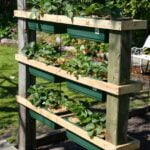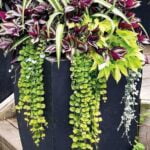Upcycled landscape ideas are increasingly popular as people look for sustainable and creative ways to enhance outdoor spaces. Upcycling involves repurposing and transforming discarded or unused materials into something of higher value, and it has become a significant trend in landscaping. In this section, we will explore the concept of upcycling and its relevance in landscaping, providing insights into the benefits and opportunities it presents.
Upcycling is more than just a trend; it is an essential practice that promotes environmental sustainability. By reusing materials that would otherwise end up in landfills, upcycling reduces waste and minimizes the need for new resources. In landscaping, upcycled materials can add unique character and charm to outdoor spaces while reducing the environmental impact of traditional landscaping practices.
In addition to its environmental benefits, upcycled landscaping offers a range of advantages for homeowners and landscapers, from cost savings to creative freedom. Throughout this article, we will delve deeper into various aspects of upcycled landscaping, from garden art and decor ideas to incorporating upcycled materials in hardscaping and DIY furniture projects. Whether you are a seasoned professional or an enthusiastic DIYer, embracing upcycled landscape ideas can inspire innovative designs while contributing to a more sustainable future.
Benefits of Upcycled Landscaping
Upcycled landscaping offers a variety of benefits, both for the environment and for your outdoor space. By incorporating upcycled materials into your landscaping design, you not only reduce waste but also add unique character and charm to your yard. Here are some key benefits of upcycled landscaping:
1. Environmental impact: Upcycling reduces the amount of waste that ends up in landfills, helping to minimize the environmental impact of discarded materials. By repurposing items such as old tires, wooden pallets, and broken pottery into functional and aesthetic elements in your landscape design, you contribute to a more sustainable approach to outdoor living.
2. Cost-effectiveness: Upcycling can also be a budget-friendly option for enhancing your outdoor space. Instead of purchasing new materials, you can often find upcycled items for free or at a low cost, saving money on landscaping supplies while still achieving an attractive and innovative look for your garden or patio.
3. Creativity and uniqueness: One of the most enjoyable aspects of upcycled landscaping is the opportunity to get creative with unexpected materials. From using old ladders as trellises to turning vintage kitchenware into planters, upcycling allows you to infuse your outdoor space with one-of-a-kind decor and features that reflect your personal style.
Incorporating upcycled landscape ideas not only supports eco-friendly practices but also adds character, affordability and originality to your outdoor environment. Whether you’re transforming a small urban garden or a sprawling backyard, embracing upcycled landscaping can enhance both the aesthetic appeal and sustainability of your outdoor space.
Upcycled Garden Art and Decor Ideas
Upcycling is the process of taking old or discarded items and repurposing them into something new and useful. When it comes to landscaping, upcycling is an important practice that not only reduces waste but also adds charm and character to outdoor spaces. One of the easiest ways to incorporate upcycled materials into your landscape design is through garden art and decor. Here are a few ideas to get you started:
- Broken pottery or ceramic tiles can be used to create colorful mosaic stepping stones for paths and walkways.
- Old bicycle wheels or metal scraps can be transformed into unique sculptures or wind chimes to add visual interest to your garden.
- Salvaged wood or driftwood can be crafted into decorative signs, birdhouses, or plant markers for a rustic touch.
In addition to adding visual appeal, upcycled garden art and decor also contribute to sustainability by giving new life to items that would otherwise end up in landfills. By incorporating these creative touches into your landscape design, you not only bring your outdoor space to life but also make a positive impact on the environment.
Utilizing upcycled materials in hardscaping can further enhance the eco-friendly aspect of your landscape design. For example:
- Old bricks or concrete pavers can be repurposed as edging for flower beds or as pathways throughout the garden.
- Reclaimed lumber can be used to construct functional elements such as benches, tables, or pergolas for outdoor seating areas.
- Vintage doors or windows can be transformed into decorative privacy screens or focal points in the garden.
Incorporating these upcycled elements not only adds character and charm to your outdoor space but also reduces the need for new materials, further lessening the environmental impact of your landscaping project. With a little creativity and resourcefulness, you can transform everyday items into beautiful and functional additions to your landscape.
Incorporating Upcycled Materials in Hardscaping
When it comes to hardscaping, using upcycled materials can add a unique and environmentally friendly touch to your outdoor space. From pathways and patios to retaining walls and fences, there are plenty of creative ways to incorporate upcycled materials into your hardscaping design. One popular idea is using reclaimed bricks or stones for a classic and rustic look. Not only does this give old materials a new life, but it also adds character to your outdoor space.
Another innovative way to use upcycled materials in hardscaping is by repurposing old concrete or metal objects for decorative elements. For example, old metal gates or grates can be transformed into unique arches or trellises for climbing plants. Similarly, broken concrete pieces can be used to create mosaic pathways or decorative accents in the garden. These upcycled elements not only reduce waste but also make your hardscaping design one-of-a-kind.
Furthermore, incorporating salvaged wood into hardscaping projects is a sustainable and aesthetically pleasing choice. Reclaimed wood can be used for building pergolas, decks, and fencing, adding warmth and charm to outdoor spaces. Whether it’s repurposed from old barns, shipping pallets, or industrial structures, upcycled wood brings a sense of history and eco-friendliness to the landscape design.
| Upcycled Material | Hardscape Application |
|---|---|
| Reclaimed Bricks/Stones | Pathways, Patios |
| Repurposed Metal/Concrete | Decorative Archways, Mosaic Pathways |
| Salvaged Wood | Pergolas, Decks, Fencing |
Upcycled Planters and Containers
Upcycling materials for planters and containers is not only an eco-friendly way to add charm and character to your landscape, but it also provides a unique and personalized touch to your outdoor space. There are numerous upcycled landscape ideas for planters and containers that can easily be incorporated into any garden or outdoor area.
Repurposed Tyres and Drums
One popular upcycling idea for planters is the use of old tires or drums. By adding some color or decorative touches, these items can be transformed into eye-catching planters for flowers, herbs, or even small trees. This not only prevents these items from sitting in a landfill but also gives them new life as a functional and aesthetically pleasing addition to your landscape.
Pallet Planters
Another creative way to upcycle materials for planters is by using discarded pallets. These versatile structures can easily be turned into vertical gardens, herb planters, or even large container gardens. With a little bit of creativity and carpentry skills, pallets can be transformed into stylish and practical planters that blend seamlessly into your outdoor space.
Salvaged Containers
Finally, salvaging old containers such as tin cans, wooden crates, or vintage buckets can provide a charming and rustic flair to your garden. These items can be repainted, reclaimed, or left in their natural state to create a unique and eclectic look. Utilizing salvaged containers not only reduces waste but also adds personality and character to your outdoor oasis.
By incorporating upcycled materials into your planters and containers, you not only contribute to sustainability efforts but also showcase your creativity in making something beautiful out of discarded items. The possibilities are endless when it comes to creating one-of-a-kind planter designs using upcycled materials.
DIY Upcycled Furniture for Outdoor Spaces
Upcycling old, unwanted furniture and turning it into beautiful pieces for outdoor spaces is not only a sustainable and eco-friendly practice but also a creative way to add character and charm to your landscape. By giving new life to old furniture, you can save money, reduce waste, and create unique outdoor furnishings that reflect your personal style.
One popular upcycled furniture idea for outdoor spaces is using old wooden pallets to create sturdy and stylish patio seating. With some basic carpentry skills and a few tools, you can transform pallets into comfortable benches, loungers, or even an outdoor dining set. Additionally, old crates or barrels can be repurposed as end tables or coffee tables for your patio or deck.
Another creative upcycled furniture idea is using discarded tires to make durable and eye-catching outdoor seating. By cutting tires in half, adding a cushion or seat pad, and arranging them in a circular pattern, you can create unique tire chairs or ottomans. This not only gives old tires a new purpose but also adds an eclectic touch to your outdoor space.
For those with a knack for woodworking, upcycling old doors or windows into outdoor furniture pieces such as tables, chairs, or plant stands can be a rewarding project. By sanding down the wood, adding a fresh coat of paint or sealant, and pairing it with sturdy metal legs or frames, you can create one-of-a-kind furniture that brings personality to your garden or patio while reducing the demand for new materials.
When considering DIY upcycled furniture for outdoor spaces, the possibilities are abundant. From repurposing old metal drums into side tables to transforming vintage ladders into plant shelves, there are endless opportunities to showcase creativity while contributing positively towards environmental sustainability with these upcycled landscape ideas.
Upcycled Water Features and Irrigation Systems
Upcycling is an innovative and sustainable approach to landscaping that involves repurposing discarded materials into functional and aesthetic elements for outdoor spaces. When it comes to water features and irrigation systems, upcycling offers a wide range of possibilities for creating unique and eco-friendly landscape designs. From rainwater harvesting systems made from reclaimed barrels to upcycled fountains crafted from salvaged materials, there are plenty of creative ways to incorporate upcycled elements into your outdoor environment.
One of the key benefits of using upcycled water features and irrigation systems is the reduction of waste and environmental impact. By utilizing materials that would otherwise end up in landfills, you are not only contributing to the conservation of natural resources but also minimizing the carbon footprint of your landscaping project. Additionally, upcycled water features can help promote biodiversity by providing habitats for local wildlife, such as birds and insects.
When it comes to designing upcycled water features, think beyond traditional fountains or ponds. Consider repurposing items like old bathtubs, sinks, or even industrial piping to create eye-catching water elements that add character to your landscape.
For irrigation systems, explore using recycled hoses, PVC pipes, or plastic bottles to construct efficient and cost-effective watering solutions for your plants and garden beds. Embracing the challenge of working with unconventional materials can lead to truly innovative and environmentally conscious results in your outdoor space.
Incorporating upcycled water features and irrigation systems into your landscape not only showcases creativity but also demonstrates a commitment to sustainability. By thinking outside the box and finding new purposes for old items, you can transform your outdoor environment while contributing positively to the planet. Whether you are revamping an existing landscape or starting from scratch, exploring upcycled water feature ideas can offer a refreshing perspective on responsible design practices within landscaping.
| Benefits | Examples |
|---|---|
| Reduction of waste | Rainwater harvesting systems made from reclaimed barrels |
| Environmental impact | Upcycled fountains crafted from salvaged materials |
| Promotion of biodiversity | Providing habitats for local wildlife through upcycled water features |
Tips for Finding and Utilizing Upcycled Materials
Whether you are a seasoned gardener or just starting out, incorporating upcycled materials into your landscape can add unique charm and sustainability to your outdoor space. The key to successful upcycled landscaping lies in finding and utilizing the right materials. Here are some tips to help you source and repurpose materials for your next landscaping project.
Scouring Flea Markets and Thrift Stores
One of the best places to find upcycled materials for your landscape is at flea markets and thrift stores. You never know what treasures you may stumble upon, from vintage garden tools to old pieces of furniture that can be transformed into planters. Keep an open mind and envision how each item can be repurposed to add character to your outdoor space.
Repurposing Salvaged Materials
Another great way to find upcycled materials is by visiting salvage yards or architectural salvage companies. These places often have a treasure trove of items such as reclaimed wood, antique hardware, and vintage fixtures that can be used in hardscaping, garden decor, or as creative planters. Repurposing salvaged materials not only gives them a new life but also adds a unique touch to your landscape design.
Networking With Local Builders and Contractors
Networking with local builders and contractors can also yield an abundance of upcycled materials for your landscaping projects. Many construction sites have leftover or discarded materials that can be repurposed for outdoor use. By establishing relationships with these professionals, you may have access to items like reclaimed bricks, stone remnants, or discarded lumber that would otherwise go to waste.
By implementing these tips for finding and utilizing upcycled materials in your landscape projects, you can contribute to sustainability while adding creativity and personality to your outdoor space. With some creativity and resourcefulness, the possibilities for incorporating upcycled elements into your landscaping are endless.
Case Studies
In recent years, the concept of upcycling has gained momentum in the world of landscaping. One of the key aspects of upcycling is to repurpose and reimagine discarded materials, giving them a new lease on life within landscape design. This approach not only reduces waste but also adds unique character and creativity to outdoor spaces. The use of upcycled landscape ideas has given rise to several successful projects that serve as inspiring examples for homeowners and designers.
One notable case study is the transformation of an urban rooftop into a thriving garden oasis using upcycled materials. By repurposing old wooden pallets into vertical planters, the otherwise unused space was turned into a lush green sanctuary. Additionally, salvaged metal drums were creatively transformed into water features, adding a sense of tranquility to the bustling city environment. This project exemplifies how upcycling can not only enhance aesthetics but also contribute to sustainability in urban landscapes.
Another compelling example is the renovation of a neglected industrial site into a community park using upcycled hardscape materials. Through innovative thinking and resourcefulness, old railroad ties were repurposed as seating benches, while discarded concrete blocks were stacked to create retaining walls and raised planters. This project showcases how upcycled materials can be integrated seamlessly into hardscaping, adding layers of history and character to public outdoor spaces.
Furthermore, there are numerous instances where DIY enthusiasts have utilized upcycled furniture for outdoor areas, showcasing both craftsmanship and environmental mindfulness. From repurposed wooden crates as coffee tables to reclaimed tire swings hanging from tree branches, these projects demonstrate the potential for creativity and sustainability in outdoor living spaces. These case studies stand as proof that with ingenuity and dedication, upcycled landscape ideas can result in remarkable transformations that benefit both individuals and the environment.
Conclusion
In conclusion, upcycled landscape ideas offer a sustainable and creative approach to landscaping that not only benefits the environment but also adds a unique aesthetic to outdoor spaces. By repurposing and reusing materials, individuals can significantly reduce their ecological footprint while adding character and charm to their gardens and yards. The benefits of upcycled landscaping are numerous, from minimizing waste to reducing costs and promoting resourcefulness.
Furthermore, upcycled landscape ideas extend beyond just using materials in garden beds or hardscaping. Incorporating upcycled garden art and decor, DIY furniture, water features, and irrigation systems adds an extra layer of personality to outdoor spaces. From reclaimed wood planters to recycled metal sculptures, the possibilities for incorporating upcycled elements into landscaping are endless.
Embracing sustainability and creativity in landscaping with upcycled ideas is not only fulfilling but also sets a positive example for others in the community. As more individuals and businesses adopt upcycling practices in landscaping, we can collectively work towards a greener, more conscious approach to outdoor design. By finding and utilizing upcycled materials while keeping an eye on practicality and aesthetics, anyone can create an environmentally friendly and visually stunning landscape.
Frequently Asked Questions
How Do You Repurpose Things for the Garden?
I repurpose things for the garden by getting creative with items like old tires, wooden pallets, or even kitchen containers. For example, I’ve used old tires as planters by painting them and stacking them in an attractive way. Wooden pallets have been transformed into vertical gardens, and I’ve also upcycled old kitchen containers into herb planters.
What Are Some Upcycling Projects?
There are countless upcycling projects that can be done, ranging from turning mason jars into candle holders to transforming wine bottles into decorative vases. Some other ideas include using old denim jeans to make plant pot covers, creating a bird feeder out of a milk jug, or repurposing an old ladder as a trellis for climbing plants.
What Objects Can Be Upcycled?
Many objects can be upcycled to serve a new purpose. Common options include glass bottles, plastic containers, tin cans, furniture, clothing, and even old windows or doors. With some creativity and DIY skills, these items can be transformed into useful and attractive additions to the garden or home without needing to be thrown away or recycled.

Welcome to my gardening blog! I am passionate about plants and enjoy sharing my knowledge and experiences with others. In this blog, I will write about everything related to gardening, from tips on how to get started to updates on my own garden projects.





